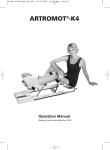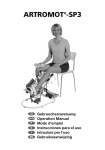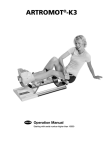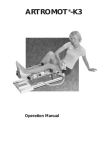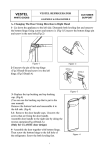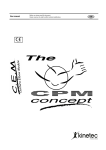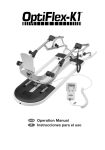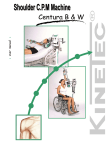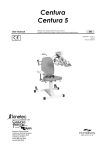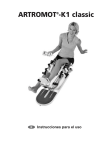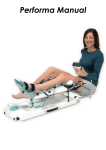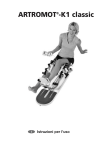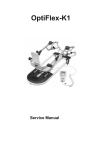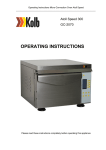Download ARTROMOT®-K1 classic
Transcript
ARTROMOT®-K1 classic USA/GB Operation Manual Device description 1 23 4 5 6 7 7 8 9 10 11 12 13 4 3 2 15 19 7 8 9 3 18 17 16 14 Contents ARTROMOT®-K1 classic description 3 ARTROMOT®-K1 classic setup illustrations 1. 2. 3. 4. 5. 6. 150 How to use the CPM device 29 1.1 1.2 1.3 1.4 29 29 29 29 Fields of application Therapy objectives Indications Contraindications ARTROMOT®-K1 classic description 30 2.1 2.2 2.3 2.4 30 31 33 34 Description of the device components Description of the programming unit Explanation of symbols Explanation of symbols (connections and nameplate) Safety information 35 Device setup 38 4.1 Connecting the device, performance check 4.2 Adjusting the device to the femur length 4.3 Adapting the leg support assemblies/footplate 38 38 39 Setting the treatment values 5.1 General information on programming ARTROMOT®-K1 classic 5.2 Information about the ARTROMOT®-K1 classic therapy parameters 40 40 41 Care, maintenance, transport 42 6.1 Care 6.2 Maintenance (fuse replacement) 6.3 Transport 42 42 43 7. Environmental Protection Statement 43 8. Specifications 43 9. IEC 60601-1-2:2001 44 9.1 Electromagnetic emissions 9.2 Electromagnetic immunity 9.3 Recommended Separation Distances 44 45 47 10. How to reach us 47 11. Technical service 48 11.1 Technical hotline 11.2 Shipment 11.3 Spare parts 48 48 48 12. Declaration of conformity 49 28 1. How to use the CPM device 1.3 Indications ARTROMOT®-K1 classic is a motoroperated Continuous Passive Motion (CPM) device used to mobilize knee and hip joints. The CPM device is indicated in the treatment of most injuries and diseases of the knee and hip joints as well as in the postoperative treatment after knee and hip joint surgery. Examples: Suitable for use in hospitals, clinics, general practices and rental services, it is an important supplement to medical and therapeutic treatment. - joint distortion and contusion - arthrotomy and arthroscopy procedures in combination with synovectomy, arthrolysis or other intra-articular interventions 1.2 Therapy objectives - mobilization of joints in anesthetized patients CPM therapy with ARTROMOT®-K1 classic is mainly used to prevent the negative effects of immobilization, to allow patients to regain painless mobility of joints at an early stage and to promote healing and achieve a positive functional result. - operative treatment of fractures, pseudoarthrosis and osteotomy - cruciate ligament replacement or reconstruction - endoprosthetic implant Other objectives of therapy include: 1.4 Contraindications - improvement of joint metabolism - prevention of joint stiffness Do NOT use ARTROMOT®-K1 classic on patients with: - promotion of the regeneration and healing of cartilage and damaged ligaments - faster hematoma/fluid resorption - acute inflammatory processes in the joints, unless on the order of a physician - improved lymph and blood circulation - spastic paralysis - thrombosis and embolism prophylaxis - unstable osteosynthesis 29 English 1.1 Fields of application 2. ARTROMOT®-K1 classic description 7. Clamping lever to adjust the height of the calf support assembly The motorized CPM device permits extension and flexion of the knee joint in the range of -10°/0°/120°, and of the hip joint in the range of 0°/7°/115°. 8. Calf length fixation screws (tibia length) 9. Calf length scale (tibia length scale) It can be used on either side and requires no configuration change. 10. Strap to secure the foot to the footplate These are some of the outstanding ARTROMOT®-K1 classic features: 11. Footplate - anatomically correct setup 12. Footplate angle fixation screw - physiological movements 13. Clamping lever to adjust footplate rotation and level and to remove the footplate - programming unit for precise adjustment of patient-specific therapy parameters 14. Connection for programming unit - symbols for easy operation of the programming unit 15. Connection for power cord 16. Fuse cap 17. Power switch (ON/OFF) Biocompatibility 18. Nameplate The parts of the ARTROMOT®-K1 classic device that come in contact with the patient during the intended use, are designed to fulfill the biocompatibility requirements of the applicable standards. 19. Programming unit 2.1 Description of the device components Note: Please fold out page 3! 1. Thigh support assembly 2. Clamping lever to adjust the height of the thigh support assembly 3. Thigh length scale (femur length scale) 4. Thigh length fixation screws (femur length) 5. Knee hinge 6. Calf support assembly 30 2.2 Description of the programming unit selected angle of the CPM device set extension value set flexion value selected direction of motion Extension control Flexion control Pause control Speed control START/STOP key (during operation: LED green, when stopped: LED yellow) 31 English 2.2.1 Programming unit in normal mode 2.2.2 Programming unit in speed or pause programming mode set value of selected function (here: speed) selected function 32 2.3 Explanation of symbols Symbols that may appear in the display Extension (stretching the knee) Go to start position (see Notes in 4.1) Flexion (bending the knee) Controls on programming unit locked (see Notes in 5.1) Speed Controls on programming unit unlocked (see Notes in 5.1) Pause (extension and flexion) Service menu activated, for service purposes only (also refer to Service Manual) 33 English Symbols on the programming unit: 2.4 Explanation of symbols (connections and nameplate) Alternating current Protective earth connection Type B applied part Power switch OFF Power switch ON Refer to accompanying documents Do not dispose product with unsorted household or municipal waste. 34 3. Safety information Introduction and definitions Safety information Read the safety statements before use of the CPM device. The safety statements are classified as follows: ARTROMOT®-K1 classic is not designed for use in areas where an explosion hazard may occur. An explosion hazard may result from the use of flammable anesthetics, skin cleansing agents and disinfectants. DANGER! Indicates an imminent hazard. If not avoided, this hazard will result in death or serious injury. WARNING! WARNING! Indicates a hazard. If not avoided, this hazard can result in death or serious injury. Patient hazard – - Only authorized individuals are allowed to operate the ARTROMOT®-K1 classic device. Individuals are authorized after receiving training in the operation of the device and reading this operation manual. CAUTION! Indicates a potential hazard. If not avoided, this hazard can result in minor personal injury and/or product/property damage. - Before using the device, the operator must ascertain that it is in correct working order and operating condition. In particular, the cables and connectors must be checked for signs of damage. Damaged parts must be replaced immediately, with original spare parts. - Before therapy, a test run consisting of several exercise cycles must be completed, first without and then with the patient. Check that all fixation screws are tightened. - Stop therapy immediately, when you have doubts about the device settings and/or the therapy protocol. 35 English DANGER! Explosion hazard – WARNING! WARNING! Patient hazard – Shock hazard – Strictly observe the following warnings. Failure to do so endangers the lives of the patient, the user and other persons involved. - It is important that the patient's position is anatomically correct. Therefore, carefully verify the following settings/positions: 1. 2. 3. 4. - Allow ARTROMOT®-K1 classic to reach room temperature before use. If the device has been transported at temperatures below 0 °C/ 30°F), leave it to dry at room temperature for about 2 hours, until any condensation has disappeared. femur length knee joint axis tibia length and leg rotation leg support assemblies - Movements must not cause pain or irritation. - Patients must be fully conscious while being instructed in the use of the CPM device and during therapy. - The ARTROMOT®-K1 classic device must only be operated in dry rooms. - When disconnecting the device from the power line, remove the plug from the wall outlet first, before disconnecting the cable from the device. - Only the responsible physician or therapist is able and allowed to choose the therapy parameters to use. It is the physician's or therapist's decision whether or not to use the CPM device on a specific patient. - When connecting the device to other equipment or when creating a medical system, check that the sum of leakage currents will not cause any hazard. Please contact ORMED, if you have questions in this matter. - The patient must be familiar with the functions of the ARTROMOT®-K1 classic programming unit and the unit must be within easy reach of the patient, allowing him or her to stop therapy, if needed. Patients unable to operate the programming unit, e.g. paralytic patients, must never be left unattended during therapy. - Do not use multiple portable socket outlets (MPSO) to connect the device to the power line. ARTROMOT®-K1 classic must be connected to a properly installed wall outlet with a non-fused earthed wire. Before connecting the power cord, it must be completely unrolled and placed such that it will not get caught by the moving parts of the device. - Any accessories used with ARTROMOT®-K1 classic must first be approved by ORMED. - Do not allow parts of the body or objects (such as blankets, cushions, or cables) to get caught in the moving parts of the CPM device. - Before cleaning and service interventions, disconnect the device from the power line by removing the power cord from the wall outlet. - Liquids must not be allowed to enter the CPM device or the programming unit. If liquids have entered into the devices, ARTROMOT®-K1 classic must be immediately checked by a service technician, before it can be reused. 36 CAUTION! Equipment damage – - Magnetic and electrical fields are capable of interfering with the proper performance of the device. For this reason make sure that all external devices operated in the vicinity of the CPM device comply with the relevant EMC requirements. X-ray equipment, MRI devices and radio systems are possible sources of interference as they may emit higher levels of electromagnetic radiation. Keep the CPM device away from these devices and verify its performance before use. - Check that the voltage and frequency ratings of your local power line are those indicated on the nameplate. - The leg support element withstands a maximum continuous load of 20 kg. - Do not allow any objects (such as blankets, cushions, or cables) to get caught in the moving parts of the CPM device. - Do not expose the ARTROMOT®-K1 classic device to direct sunlight, because some of the components may reach inadmissibly high temperatures. - Refer repair and maintenance to authorized persons. - Route all cables below the device frame to either side, ensuring that they cannot get caught by the moving parts during operation. - Inspect ARTROMOT®-K1 classic for damage and loose connections at least once a year. Damaged and worn parts must immediately be replaced with original spare parts by authorized staff. CAUTION! Preventing chafing and pressure sores – When your patient is adipose, very tall or very short, be sure to prevent chafing and pressure sores. Place the leg concerned in a moderate abduction position, if deemed appropriate. 37 English WARNING! Equipment malfunction – 4. Device setup ARTROMOT®-K1 classic enters the home position (for home position values, refer to section 4.1), the device has passed the performance check. Note: For a better understanding of each step, please fold out pages 3 and 150. 4.1 Connecting the device, performance check The device also runs performance checks regularly during operation. This is what happens, if a problem is identified: - An audio signal sounds. - The device switches off immediately. - The message “ERROR”, accompanied by a code number (e.g. ERROR 5), appears on the display. 1. Connect the power cord to socket (15) of the device and mains plug to a wall outlet with a non-fused earthed wire (100 to 240 Volt, 50/60 Hz). In this situation, you may attempt to restart the device by turning the device briefly off and on again with the power switch. If the error message persists, have the device inspected by a Service technician, before using it again. 2. Turn the power switch (17) on. 3. Follow these steps to set the carriage to the home position. Press the Extension key 4.2 Adjusting the device to the femur length and, holding it depressed, rotate until 30° appears in the display above the control. 1. Measure the length of the patient's thigh (femur) from the greater trochanter to the lateral knee joint cavity (Fig. A). In the same manner, select a Flexion value of 35°. 2. Set the carriage to the home position (see 4.1). Then press the START/STOP key. 3. Set the measured value at the femur scale (3) of the carriage. When the carriage has reached this range and does not stop automatically, press the START/STOP key again to stop any movement. - Loosen the two fixation screws (4). - Extend the scale (3) to the required length. Note! - Tighten the fixation screws (4) to set the scale to the new length. ARTROMOT®-K1 classic will stop automatically in the home position range, only if it was positioned outside this range (30° to 35°) at the time of programming (also refer to 5.2) CAUTION! Equipment damage – Do not attempt to extend the femur scale beyond the stop. Performance check If the programming unit can be operated as described above and 38 4.3 Adapting the leg support assemblies/footplate CAUTION! Equipment damage – 1. Set the leg support assemblies and the footplate (1, 6, 11) to the expected positions before accommodating the patient. - Loosen fixation screws (8) to adjust the footplate (11) to the length of the patient's lower leg (Fig. C). CAUTION! Patient hazard – Loosen clamping lever (13) and adapt the footplate's rotation and height to the patient (Fig. D). Ensure that the rotational axes of the CPM device and of the knee joint coincide both in the vertical and in the horizontal plane (Fig. G). Loosen fixation screw (12) and adapt the angle to the patient's foot (turn the screw a few revolutions until the footplate can be easily adjusted). Symbol 1: Measurement of the patient's femur length from the greater trochanter to the knee joint cavity For short patients you can reverse the footplate's bracket 180° (Fig. H) to adapt the footplate to shorter calves: • Loosen clamping lever (13) and remove the footplate (11). Symbol 2: Set the carriage to the home position (see 4.1) and adjust it to the measured femur length. • Loosen the fixation screws (12). • Reverse the bracket 180°. • Screw the footplate to the bracket and tighten the clamping lever. Note! Symbol 3: Adjust height of calf and thigh support assemblies. Adjust the footplate to the height and length of the lower leg. When reversing the footplate, ensure that the pins below the clamping lever engage with the recesses in the bracket. - To adjust the height of the support assemblies for calf (1) and thigh (6), loosen clamping levers (2) and (7) (Figs. E/F). 2. Place the patient’s leg on the carriage and repeat the steps outlined under 1 above to adjust the device to the patient. 39 English Cover the leg support assemblies with disposable tissues when using ARTROMOT®-K1 classic immediately after surgery. This helps prevent discoloration. 5. Setting the treatment values When adjusting speed or pause, the information shown in the display changes automatically as you press the control. WARNING! Patient hazard – Before therapy, a test run consisting of several exercise cycles must be completed without the patient. Then repeat the test run with the patient and check that the movement does not cause any pain. The selected parameter (speed or pause) is immediately represented by its symbol in a large format plus the current value (also refer to 2.2.2). The current value can be changed by turning the depressed control. When you have set the new value, release the control and the standard display reappears automatically after approx. 5 seconds (see also 2.2.1). Note! See also 2.2 and 2.3 as well as page 150! 3. Subsequently press the START/STOP key to start therapy. 5.1 General information on programming ARTROMOT®-K1 classic Note! Refer to sections 5.2 for a description of the parameters. - To prevent accidental changes of the parameter settings, lock the programming unit by simultaneously pressing the "Extension" and "Speed" controls. 1. You activate a function by briefly pressing a control on the programming unit. 2. You select a treatment value by pressing the respective control and turning it in either direction. Press both controls again to unlock. You increase a value by turning the control clockwise towards the + (plus) symbol and you decrease a value by turning the control counterclockwise towards the - (minus) symbol. - Emergency stop function: ARTROMOT®-K1 classic will stop immediately, when any of the keys is pressed during therapy. Patient treatment can be resumed by pressing the START/STOP key. The device will automatically change the direction. For the first 5° the values in the display change in steps of 1°, then the interval changes to 5° so that you reach the target value faster. During adjustment of the extension and flexion angles, the values in the display change as you turn the control after pressing it. 40 Note! - If the carriage is positioned within the programmed range of motion at the time therapy begins, the therapy session will start immediately. The programmed value and the value measured at the patient's knee may deviate slightly. If the carriage is positioned outside the programmed range of motion at the time therapy starts, it will first enter the position “extension +10°”. The carriage will stop in this position and you can initiate the therapy session by pressing the START/STOP key again. The speed can be adjusted between 5 % and 100 % in steps of 5 %. Default setting: 50 % ■ Pauses Pauses occur at the selected limits where stretching turns into bending and bending into stretching (selected extension and flexion values). The value entered applies to both extension and flexion pause. 5.2 Information about the ARTROMOT®-K1 classic therapy parameters Pauses can be set to any value between 0 and 59 seconds in steps of 1 second, and to values between 1 and 59 minutes in steps of 1 minute. When selecting the seconds, the value changes in 1-second steps for the first five seconds. Subsequently the interval changes to 5-second steps. - You select a function by pressing the corresponding control - You change the treatment values by turning the depressed control. - You initiate the treatment session by pressing the START/STOP key The minutes are always adjusted in 1-minute steps. Default setting: no pause ■ Extension (streching) - Maximum knee extension: -10 degrees - Maximum hip extension: 7 degrees ■ Flexion (bending) - Maximum knee flexion: 120 degrees - Maximum hip flexion: 115 degrees 41 English ■ Speed 6. Care, maintenance, transport 6.1 Care 6.2 Maintenance (fuse replacement) WARNING! Shock hazard – Check before each use Unplug the device from the power line before cleaning. Visually inspect the device for signs of mechanical damage before each use. Shock hazard, equipment damage – Liquids must not enter the device or the programming unit. If you detect damage or malfunctions that may impair the safety of the patient or of the operator, have the device repaired before using it. - ARTROMOT®-K1 classic can be disinfected by wiping down with a disinfectant. Thus, it complies with the special hygiene standards for medical technical equipment. Technical Inspections For safety, the devices require regular maintenance. To maintain the functional and operational safety, check all components for damage and loose connections at least once a year. - The enclosure and removable leg support assemblies can be cleaned with commonly used disinfectants and mild household detergents. These checks should be performed by persons with adequate training and experience. Damaged and worn parts must immediately be replaced with original spare parts by authorized staff. - Use only a damp cloth to wipe the carriage down. Clean the sheath of the programming unit on a regular basis. Remove it from the programming unit before cleaning. Allow the sheath to dry before inserting the programming unit again. The checks can be carried out by ORMED within the framework of a service agreement. Contact ORMED for details. The device does not require additional regular maintenance. CAUTION! Fuse replacement Equipment damage – - The plastic material used is not resistant to mineral acids, formic acid, phenols, cresols, oxidizing agents and strong organic or inorganic acids with a pH value below 4. WARNING! Patient hazard, equipment malfunction and damage – The replacement of fuses must be referred to specialists as defined in IEC 60364 or similar standards (e.g. biomedical technicians, electricians, electronics installers). - Use only clear disinfectants to prevent discoloration of the device. - Do not expose the CPM device to strong ultraviolet radiation (sunlight) and fire. Fuses used must be T1A fuses. 42 6.3 Transport 7. Environmental protection statement The product described in this operation manual must not be dispose of with unsorted household or municipal waste. It requires separate disposal. Please contact ORMED for information about the possible recycling of the product. 1. Adjust the femur length to 49 cm and the tibia length to 45 cm. 2. Set the carriage to 0° by pressing the START/STOP key when the carriage is in the 0° position. This will stop the carriage in that position 3. Push the power switch to turn off the ARTROMOT®-K1 classic. 8. Specifications 4. Disconnect the power cord and the programming unit. Input ratings: 5. The device must be stored in its original shipping box for transport. ORMED GmbH & Co. KG cannot be held liable for damage in transit, if the original shipping box was not used. 6. Inser the programming unit into the space provided in the molded polystyrene pads and secure with adhesive tape. 7. Set the footplate to a horizontal position. 9. Place the power cord at the bottom of the box before inserting the ARTROMOT®-K1 classic including the polystyrene pads. Programming Unit Current consumption: 850 – 370 mA Fuses: 2 x T1A Protection class: I Applied part: type B Max. load on carriage: 20 kg Dimensions length: width: height: 8. Now slide the polystyrene pads onto the ARTROMOT®-K1classic. 100 – 240 V AC/ 50 – 60 Hz 96 cm 35 cm min. 23 cm to max. 56 cm Adjustment ranges (min./max.): Femur range: approx. 31 – 49 cm Power Cord Lower leg range: approx. 25 – 57 cm Weight: 11 kg Materials used: ABS, POM (Delrin 100), PUR, PA, FR4, aluminium, stainless steel, brass MDD class 2a Standards compliance: IEC 60601-1:1988 + A1:1991 + A2:1995 Certification: 43 ANSI/UL 60601-1 CAN/CSA C22.2 No. 601.1 English Follow these steps to prepare the ARTROMOT®-K1 classic for transport: EMC (electromagnetic compatibility) IEC 60601-1 2:2001 Ambient conditions (operation) temperature: +10 ºC to +40 ºC (50 °F to +104 °F) Ambient conditions (storage, transport) temperature: -24 ºC to +60 ºC (-12 °F to +140 °F) relative humidity: atmospheric pressure: relative humidity: atmospheric pressure: 30 % to 75% 700 hPa to 1060 hPa 20 % to 85 % Subject to change without notice. (08/06) 700 hPa to 1060 hPa 9. IEC 60601-1-2:2001 The ARTROMOT®-K1 classic device is subject to particular precautions regarding electromagnetic compatibility (EMC). The device must be installed and put into service strictly in compliance with the EMC directives put forth in the accompanying documents. ARTROMOT®-K1 classic should not be used adjacent to or stacked with other equipment. If adjacent or stacked use is necessary, ARTROMOT®-K1 classic should be observed to verify normal operation in the configuration in which it will be used. Portable and mobile RF communication systems may affect the ARTROMOT®-K1 classic device. We can guarantee the specified electromagnetic emission and immunity data only if the manufacturer's original spare parts are used in repair and maintenance of the device. 9.1 Electromagnetic emissions Guidance and Manufacturer’s Declaration – Electromagnetic Emissions ARTROMOT®-K1 classic is intended for use in the electromagnetic environment specified below. It is the responsibility of the customer or user to ensure that the ARTROMOT®-K1 classic device is used in such an environment. Emissions test Compliance Electromagnetic environment – guidance RF emissions to CISPR 11 Group 1 ARTROMOT®-K1 classic uses RF energy only for its internal function. Therefore, its RF emissions are very low and are not likely to cause any interference in nearby electronic equipment. RF emissions to CISPR 11 Class B ARTROMOT®-K1 classic is suitable for use in all establishments, including domestic and those directly connected to the public low-voltage power supply network that supplies buildings used for domestic purposes. Harmonic emissions to IEC 61000-3-2 not applicable Voltage fluctuations/flicker emissions to IEC 61000-3-3 not applicable 44 9.2 Electromagnetic immunity Guidance and Manufacturer’s Declaration – Electromagnetic Immunity Electrostatic discharge (ESD) to IEC 61000-4-2 ± 6 kV contact e 6 kV contact e 6 kV contact e 8 kV air e 8 kV air Electrical fast transi- e 2 kV for power ent/burst to IEC supply lines 61000-4-5 ± 2 kV for power supply lines e 1 kV for input/output lines Surges to IEC 61000-4-5 Voltage dips, short interruptions and voltage variations on power supply input lines to IEC 61000-4-11 Mains power should be that of a typical commercial or hospital environment. e 1 kV for input/out- put lines e 1 kV differential mode e 1 kV differential e 2 kV common mode e 2 kV common mode mode Mains power should be that of a typical commercial or hospital environment. < 5 % UT (> 95 % dip in UT) for 5 s Mains power should be that of a typical commercial or hospital environment. If the user of the 40 % UT ARTROMOT®-K1 classic (60 % dip in UT) for device requires continued 5 cycle operation during power mains interruptions, it is 70 % UT recommended that the (30 % dip in UT) for ARTROMOT®-K1 classic 25 cycles device be powered from an uninterruptible power supp< 5 % UT ly or a battery. (> 95 % dip in UT) for 5 s 3 A/m 3 A/m < 5 % UT < 5 % UT (> 95 % dip in UT ) (> 95 % dip in UT ) for ) cycle for ) cycle 40 % UT (60 % dip in UT) for 5 cycle 70 % UT (30 % dip in UT) for 25 cycles Power frequency (50/60 Hz) magnetic field to IEC 610004-8 e 2 kV for power supply lines Floors should be wood, concrete or ceramic tile. If floors are covered with synthetic material, the relative humidity should be at least 30%. Power frequency magnetic fields should be at levels characteristics of a typical location in a typical commercial or hospital environment. Portable and mobile RF communications equipment are used no closer to any part of the ARTROMOT®-K1 classic device, including cables, than the recommended separation distance calculated from the equation applicable to the frequency of the transmitter. NOTE: UT is the a.c. mains voltage prior to application of the test level. 45 English ARTROMOT®-K1 classic is intended for use in the electromagnetic environment specified below. It is the responsibility of the customer or user to ensure that the ARTROMOT®-K1 classic device is used in such an environment. IEC 60601-test Compliance level Electromagnetic Immunity test level environment - guidance Guidance and Manufacturer’s Declaration – Electromagnetic Immunity ARTROMOT®-K1 classic is intended for use in the electromagnetic environment specified below. It is the responsibility of the customer or user to ensure that the ARTROMOT®-K1 classic device is used in such an environment. Immunity test IEC 60601 test level Compliance level Electromagnetic environment-guidance Recommended separation distance: Conducted RF to IEC 61000-4-6 3 Vrms 150 kHz to 80 MHz 3 Vrms Radiated RF to IEC 61000-4-3 3 V/m 80 MHz to 2.5 GHz 3 V/m d = r 1.2 öP d = 1.2 800 MHz r öP d = 2.3 2.5 GHz 80 MHz to r öP 800 MHz to where P is the maximum output power rating of the transmitter in watts (W) according to the transmitter manufacturer andd is the recommended separation distance in meters (m). Field strengths from fixed RF transmitters, as determined by an electromagnetic site survey a, is less than the compliance level in each frequency rangeb. Interference may occur in the vicinity of equipment marked with the following symbol NOTE 1: At 80 MHz and 800 MHz, the higher frequency range applies. NOTE 2: These guidelines may not apply in all situations. Electromagnetic propagation is affected by absorption and reflection from structures, objects, and people. a) Field strengths from fixed transmitters, such as base stations for radio (cellular/cordless) telephones and land mobile radio, AM and FM radio broadcast and TV broadcast cannot be predicted theoretically with accuracy. To assess the electromagnetic environment due to fixed RF transmitters, an electromagnetic site survey should be considered. If the measured field strength in the location in which the ARTROMOT®-K1 classic device is used exceeds the applicable RF compliance level above, the ARTROMOT®-K1 classic device should be observed to verify normal operation. If abnormal performance is observed, additional measures may be necessary, such as reorienting or relocating the ARTROMOT®-K1 classic device. b) Over the frequency range 150 kHz to 80 MHz, field strengths should be less than 3 V/m. 46 9.3 Recommended separation distances between portable and mobile RF communications equipment and the ARTROMOT®-K1 classic device. The ARTROMOT®-K1 classic is intended for use in an electromagnetic environment in which radiated RF disturbances are controlled. The customer or the user of the ARTROMOT®-K1 classic device can help prevent electromagnetic interferences by maintaining a minimum distance between portable and mobile RF communications equipment (transmitters) and the ARTROMOT®-K1 classic device as recommended below, according to the maximum output power of the communications equipment. separation distance according to frequency of transmitter m 150 kHz to 80 MHz d = r 1.2 öP 80 MHz to 800 MHz d = r 1.2 öP 800 MHz to 2,5 GHz d = r 2.3 öP 0.01 0.12 0.12 0.23 0.1 0.38 0.38 0.73 1 1.2 1.2 2.3 10 3.8 3.8 7.3 100 12 12 23 For transmitters rated at a maximum output power not listed above, the recommended separation distance d in meters (m) can be estimated using the equation applicable to the frequency of the transmitter, where P is the maximum output power rating of the transmitter in watts (W) according to the transmitter manufacturer. NOTE 1: For calculation of the recommended separation distance of transmitters in the frequency range from 80 MHz to 2.5 GHz an additional factor of 10/3 was taken into account to reduce the probability of mobile/portable communications equipment brought into the patient environment by accident causing any malfunction. NOTE 2: These guidelines may not apply in all situations. Electromagnetic propagation is affected by absorption and reflection from structures, objects, and people. 10. How to reach us We would be happy to answer any questions you may have about our products or services. Warranty: 2 years (mechanical parts) 2 years (electronics) ■ ORMED international Please contact your local dealer or the ORMED headquarters in Germany. Sales: ORMED GmbH & Co. KG Merzhauser Straße 112 D-79100 Freiburg ■ Headquarters Germany ORMED GmbH & Co. KG Merzhauser Straße 112 79100 Freiburg - Germany Tel. +49 761 45 66-01 Fax +49 761 45 66 55-01 ■ Internet www.ormed.de e-mail: [email protected] 47 English rated maximum output power of transmitter W 11. Technical service 11.1 Technical hotline Do you have any technical questions? Do you need technical service? Telephone: +49-180-5-1 ormed de +49-180-5-1-67 63 33 Fax: +49-180-5-3 ormed de +49-180-5-3-67 63 33 11.2 Shipment To prevent damage during transport, only use the original shipping box. These boxes can be obtained from ORMED. Before packing the CPM device, set it to the transport position (see chapter 6.3). 11.3 Spare parts Refer to the Service Manual for the most recent list of spare parts. When ordering spare parts, always specify: - item - description - part number - quantity - serial number of the CPM device Note! Refer repairs to authorized, specially trained staff. ORMED GmbH & Co. KG offers service training for your personnel. Surcharges may apply in certain cases to spare parts ordered in low quantities. 48 In compliance with the Council Directive 93/42/EEC of 14 June 1993 concerning medical devices, the company ORMED GmbH & Co. KG Merzhauser Straße 112 D-79100 Freiburg declares that the products of the product line ARTROMOT® (see Annex) fulfill the requirements of the Council Directive 93/42/EEC of 14 June 1993, Annex II as well as the essential requirements of Annex I. 0297 Freiburg, August 28th, 2006 - QA Management Representative- Annex: ARTROMOT®-S2 PRO ARTROMOT®-S3 ARTROMOT®-S3 Comfort ARTROMOT®-K1 ARTROMOT®-K2 ARTROMOT®-K2 PRO ARTROMOT®-K2 PRO Chip ARTROMOT®-K3 ARTROMOT®-K4 ARTROMOT®-SP2 ARTROMOT®-E2 ARTROMOT®-E2 compact 49 English C ONFORMITIY OF D ECLARATION Declaration of conformity ARTROMOT®-K1 classic setup illustrations A B C D E F G H 150 © ORMED 806 O R M E D G m b H & C o . K G • M e r z h a u s e r S t r a ß e 112 • D - 7 910 0 F r e i b u r g Te l + 4 9 7 6 1 4 5 6 6 - 0 1 • F a x + 4 9 7 6 1 4 5 6 6 - 5 5 0 1 • w w w. o r m e d . d e E-Mail: info @ ormed.de DIN EN 13485 ORMED Nr. 018 829-01


























